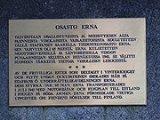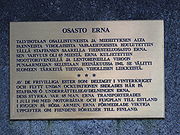
Erna long-range recce group
Encyclopedia
The Erna long-range reconnaissance group was a Finnish Army formation, of Estonian volunteers, that fulfilled reconnaissance duties in Estonia behind the Red Army
lines during World War II
. The unit was formed by Finnish military intelligence with the assistance of German military intelligence for reconnaissance operations.

.
On 22 June 1941 Nazi Germany
invaded the Soviet Union
. Finland’s entering the war on the German side was only a matter of days, and all Estonians, living in Finland were being assembled in Helsinki in order to establish a voluntary unit for going to Estonia. The platoon commander was colonel
Henn Ants Kurg of the Estonian Army, who had been the last Estonian Military Attaché to France.
Germans gave the group its name “Erna", and two German liaison officers - oberleutnant Reinhardt and Sonderführer Schwarze - had also joined the group. Erna was armed by and wearing the uniform of the Finnish army. The two Germans in charge wanted ERNA to pledge allegiance to the Führer
. However, colonel Henn Ants Kurg strongly opposed this. He insisted that they were not Germans but Estonian volunteers, ready to co-operate, but without any commitments to Hitler. After lots of disputes an agreement was reached that being in the service of the Finnish army, ERNA shall give the oath of loyalty to Finland. Accordingly, on 24 July 1941, the 15 specially trained men and 52 volunteers took an oath of allegiance to Finland
.
with 42 men arriving onshore and hiding in the Kautla Marshes 60 km south east of Tallinn
. Another 17 team members were parachuted in on 28 July. The group's task was to perform reconnaissance
deep behind Red Army lines for the Finnish Army but it turned to saving around 2,000 civilians hiding in the Kautla woods by allowing them to escape while the outnumbered Erna force engaged Soviet NKVD Destruction Battalions in a fierce battle on 31 July to 1 August 1941. On 4 August, the platoon was ordered to cross the frontline and terminate their activities. A total of 32 men were lost, either killed or missing in action.
(Baltic partisans). (Veterans of the Erna group were only a small fraction of the whole Forest Brothers resistance movement.)
These claims were reinvigorated in the 1980s as a way of distracting historians analysing the Kautla massacre
, and have been repeated in Russian media in 2000s.
The Russian Federation's original position incorrectly classifies the members 'Nazis'. Russian authorities regard the commemorative Erna retk as a “Nazi orgy” (ibid.).
Red Army
The Workers' and Peasants' Red Army started out as the Soviet Union's revolutionary communist combat groups during the Russian Civil War of 1918-1922. It grew into the national army of the Soviet Union. By the 1930s the Red Army was among the largest armies in history.The "Red Army" name refers to...
lines during World War II
World War II
World War II, or the Second World War , was a global conflict lasting from 1939 to 1945, involving most of the world's nations—including all of the great powers—eventually forming two opposing military alliances: the Allies and the Axis...
. The unit was formed by Finnish military intelligence with the assistance of German military intelligence for reconnaissance operations.

Formation of the Erna platoon
After the Soviet occupation of Estonia in 1940 hundreds of Estonian men fled to Finland rather than accept Soviet rule. The Estonian military attaché in Finland, Major Aksel Kristian, in the spring of 1941 had compiled a list of Estonians in Finland who wanted to liberate their homeland. Finnish intelligence subsequently recruited 15 volunteers and began training them on the island of Staffani in the region of EspooEspoo
Espoo is the second largest city and municipality in Finland. The population of the city of Espoo is . It is part of the Helsinki Metropolitan Area along with the cities of Helsinki, Vantaa, and Kauniainen. Espoo shares its eastern border with Helsinki and Vantaa, while enclosing Kauniainen....
.
On 22 June 1941 Nazi Germany
Nazi Germany
Nazi Germany , also known as the Third Reich , but officially called German Reich from 1933 to 1943 and Greater German Reich from 26 June 1943 onward, is the name commonly used to refer to the state of Germany from 1933 to 1945, when it was a totalitarian dictatorship ruled by...
invaded the Soviet Union
Soviet Union
The Soviet Union , officially the Union of Soviet Socialist Republics , was a constitutionally socialist state that existed in Eurasia between 1922 and 1991....
. Finland’s entering the war on the German side was only a matter of days, and all Estonians, living in Finland were being assembled in Helsinki in order to establish a voluntary unit for going to Estonia. The platoon commander was colonel
Colonel
Colonel , abbreviated Col or COL, is a military rank of a senior commissioned officer. It or a corresponding rank exists in most armies and in many air forces; the naval equivalent rank is generally "Captain". It is also used in some police forces and other paramilitary rank structures...
Henn Ants Kurg of the Estonian Army, who had been the last Estonian Military Attaché to France.
Germans gave the group its name “Erna", and two German liaison officers - oberleutnant Reinhardt and Sonderführer Schwarze - had also joined the group. Erna was armed by and wearing the uniform of the Finnish army. The two Germans in charge wanted ERNA to pledge allegiance to the Führer
Führer
Führer , alternatively spelled Fuehrer in both English and German when the umlaut is not available, is a German title meaning leader or guide now most associated with Adolf Hitler, who modelled it on Benito Mussolini's title il Duce, as well as with Georg von Schönerer, whose followers also...
. However, colonel Henn Ants Kurg strongly opposed this. He insisted that they were not Germans but Estonian volunteers, ready to co-operate, but without any commitments to Hitler. After lots of disputes an agreement was reached that being in the service of the Finnish army, ERNA shall give the oath of loyalty to Finland. Accordingly, on 24 July 1941, the 15 specially trained men and 52 volunteers took an oath of allegiance to Finland
Finland
Finland , officially the Republic of Finland, is a Nordic country situated in the Fennoscandian region of Northern Europe. It is bordered by Sweden in the west, Norway in the north and Russia in the east, while Estonia lies to its south across the Gulf of Finland.Around 5.4 million people reside...
.
Action
On the night of 10 July the platoon made a seaborne landing on the northern coast of EstoniaEstonia
Estonia , officially the Republic of Estonia , is a state in the Baltic region of Northern Europe. It is bordered to the north by the Gulf of Finland, to the west by the Baltic Sea, to the south by Latvia , and to the east by Lake Peipsi and the Russian Federation . Across the Baltic Sea lies...
with 42 men arriving onshore and hiding in the Kautla Marshes 60 km south east of Tallinn
Tallinn
Tallinn is the capital and largest city of Estonia. It occupies an area of with a population of 414,940. It is situated on the northern coast of the country, on the banks of the Gulf of Finland, south of Helsinki, east of Stockholm and west of Saint Petersburg. Tallinn's Old Town is in the list...
. Another 17 team members were parachuted in on 28 July. The group's task was to perform reconnaissance
Reconnaissance
Reconnaissance is the military term for exploring beyond the area occupied by friendly forces to gain information about enemy forces or features of the environment....
deep behind Red Army lines for the Finnish Army but it turned to saving around 2,000 civilians hiding in the Kautla woods by allowing them to escape while the outnumbered Erna force engaged Soviet NKVD Destruction Battalions in a fierce battle on 31 July to 1 August 1941. On 4 August, the platoon was ordered to cross the frontline and terminate their activities. A total of 32 men were lost, either killed or missing in action.
Aftermath
A battalion (attached to 311 Infantry regiment of German army) was formed from the remnants of the original Erna platoon, with an additional 400 men, and dubbed "Erna II", but was subsequently disbanded on 10 October 1941. With the end of the war a number of the original members of Erna continued guerrilla activities, becoming Forest BrothersForest Brothers
The Forest Brothers were Estonian, Latvian, and Lithuanian partisans who waged a guerrilla war against Soviet rule during the Soviet invasion and occupation of the three Baltic states during, and after, World War II...
(Baltic partisans). (Veterans of the Erna group were only a small fraction of the whole Forest Brothers resistance movement.)
Soviet historiography
Since the era of Stalin, Soviet propagandists have been making counterfactual assertions of the original Erna team having participated in mass murder of Soviet political activists. Sometimes, the myths also claim that the letter 'E' was cut onto the backs of the victims.These claims were reinvigorated in the 1980s as a way of distracting historians analysing the Kautla massacre
Kautla massacre
The Battle of Kautla was a battle between Soviet destruction battalions and Estonian Forest Brothers in Kautla, Estonia in July 1941. It included series of murders of civilians committed by destruction battalions, known as Kautla massacre....
, and have been repeated in Russian media in 2000s.
The Russian Federation's original position incorrectly classifies the members 'Nazis'. Russian authorities regard the commemorative Erna retk as a “Nazi orgy” (ibid.).
See also
- Erna RaidErna RaidThe Erna Raid is an annual international military exercise and competition, one of the longest and most difficult in the world, held every August since 1995 in Estonia...
, a yearly international military competition that commemorates the group's activities

